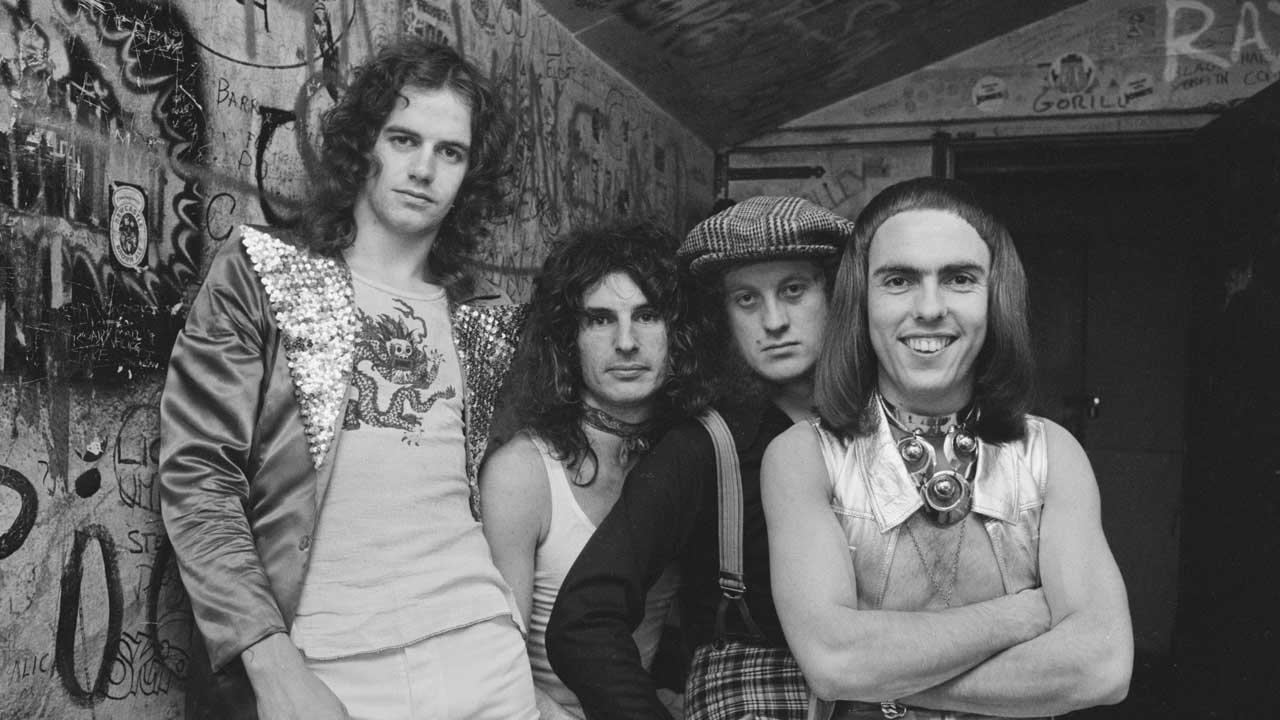
Any poll to decide Slade’s second-most famous song must include Mama Weer All Crazee Now, the band’s third UK No.1 hit, in 1972. Unlike with the Midlanders’ previous chart-toppers Coz I Luv You and Take Me Bak ’Ome, Slade had released Mama three months before its parent album, Slayed?, hoping for it to enter the singles chart in pole position – a feat previously accomplished only by The Beatles with Get Back, three years earlier.
Slade’s record label, Polydor, had considered the feat impossible. But when Mama Weer All Crazee Now debuted at No.2 before leapfrogging Rod Stewart’s You Wear It Well, the stops were pulled out to try to make the next single, the non-album track Cum On Feel The Noize, an instant chart topper. Such was the measure of Slade’s popularity in 1972, it worked.
Mama Weer All Crazee Now was the first Slade single to be based on a melody written by Jim Lea alone, after the bassist and violinist observed the audience reaction at a concert by Chuck Berry that same year.
“Everybody [in the audience] was singing [along to] his tunes. It wasn’t just a few people, it was everyone,” Lea explained years later. “I thought that was amazing – why not write the crowd into [our own] songs?”
The lyrics were written by singer and guitarist Noddy Holder following an equally raucous appearance by Slade at the NME Poll Winner’s Concert at the Empire Pool (now the Arena) in Wembley at which many seats were smashed. Surveying the aftermath, Holder thought: “Christ, everyone must have been crazy tonight.”
“There was a mountain of broken chairs in the middle of the hall,” Holder says, looking back now. “It might have happened at Empire Pool or it might have been in Liverpool, but it was somewhere massive. This was our first real concert tour [as headliners], with Quo as support, and it gave a real taste of how big the band was becoming. It was mostly a male audience, but a few girls as well, and the seats always took a real smashing. It used to cost us a fortune.”
The key words had emerged spontaneously when Holder ad-libbed a vocal part for a previous track. “In those days Chas recorded absolutely everything, bless him,” Holder tells Classic Rock, referring to the band’s producer and manager Chas Chandler, the former bassist with The Animals, who after leaving that band had managed and produced Jimi Hendrix. “I sang something during the fade-out of a track and Jim turned around and said: ‘Don’t use that. That’s a good hook, let’s use it for another song.’ So I went away and wrote the melody for that song based on the idea that Jim had had.”
Although the recollections of co-writers Holder and Lea don’t tally perfectly, the singer does acknowledge that in 1972 Slade had “just started to get into anthemic melodies that the crowd could sing along to en masse”, adding: “I think Mama was the first time that we captured that.”
By the time Holder and Lea played a primitive acoustic version of their song to Chandler, they had named it My My, We’re All Crazee Now. However, the producer misheard the title, preferred ‘Mama’ to ‘My My’ and demanded that they change it. “Chas’s version was much better,” Holder says now, grinning.
Holder has fond memories of recording the track with the ever-resourceful Chandler, who had also recorded a primal howl emitted by the singer during a vocal warm-up, and added it into the finished track before the first verse.
“The record was laid down with the four of us together, the way The Beatles had done it, usually on a first or second take,” Holder enthuses. “We were all in the same room, partitioned off but playing together as a band. I would be in a booth playing and singing live, and quite often it was the first time the band had heard me singing it. It was only then that they knew what a song was about – sometimes it was quite a shock. Any little mistakes could be patched up and the guitars double-tracked, but those recordings had a real sense of feel and spontaneity.”
Tellingly, Holder had had no idea that during the track’s latter stages he would ignore the chorus to sing: ‘Mama, mama, mama, mama, mama, mama, mama… yeah’. “That became another hook, particularly on stage,” he enthuses. “Chas said: ‘Keep it, keep it, keep it!’ Another lucky accident.”
At the time of its release in ’72, Mama Weer All Crazee Now went to No.76 in the US. There, Quiet Riot, who had previously covered Cum On Feel The Noize, later reached No.51 with a cover of Mama.
“I believe they hadn’t wanted to record another song of ours,” says Holder. “But after they did Cum On Feel The Noize pretty much as a carbon copy of our original version, their album [Metal Health] became the biggest-selling debut by any act, selling seven million copies, and I think their record company insisted. It wasn’t such a big hit for them, but their hearts weren’t really in it.”
Besides Quiet Riot, The Runaways and Mama’s Boys each tried their luck with the song. There’s even an instrumental orchestral version by James Last. “James Last did a lot of our stuff,” Holder confirms. “It’s a little-known fact that James part-owned Polydor Records in Germany, and he really loved us.”
Holder believes Mama is up there among Slade’s defining moments.
“Mama was absolutely vital to our success,” he says. “For the first time, we captured our live essence on record, via one of our own songs. It set the template with its simplicity and impulsiveness, and after it became a hit we included it in every show we ever played. So those three and a half minutes tell you everything you need to know about Slade.”







